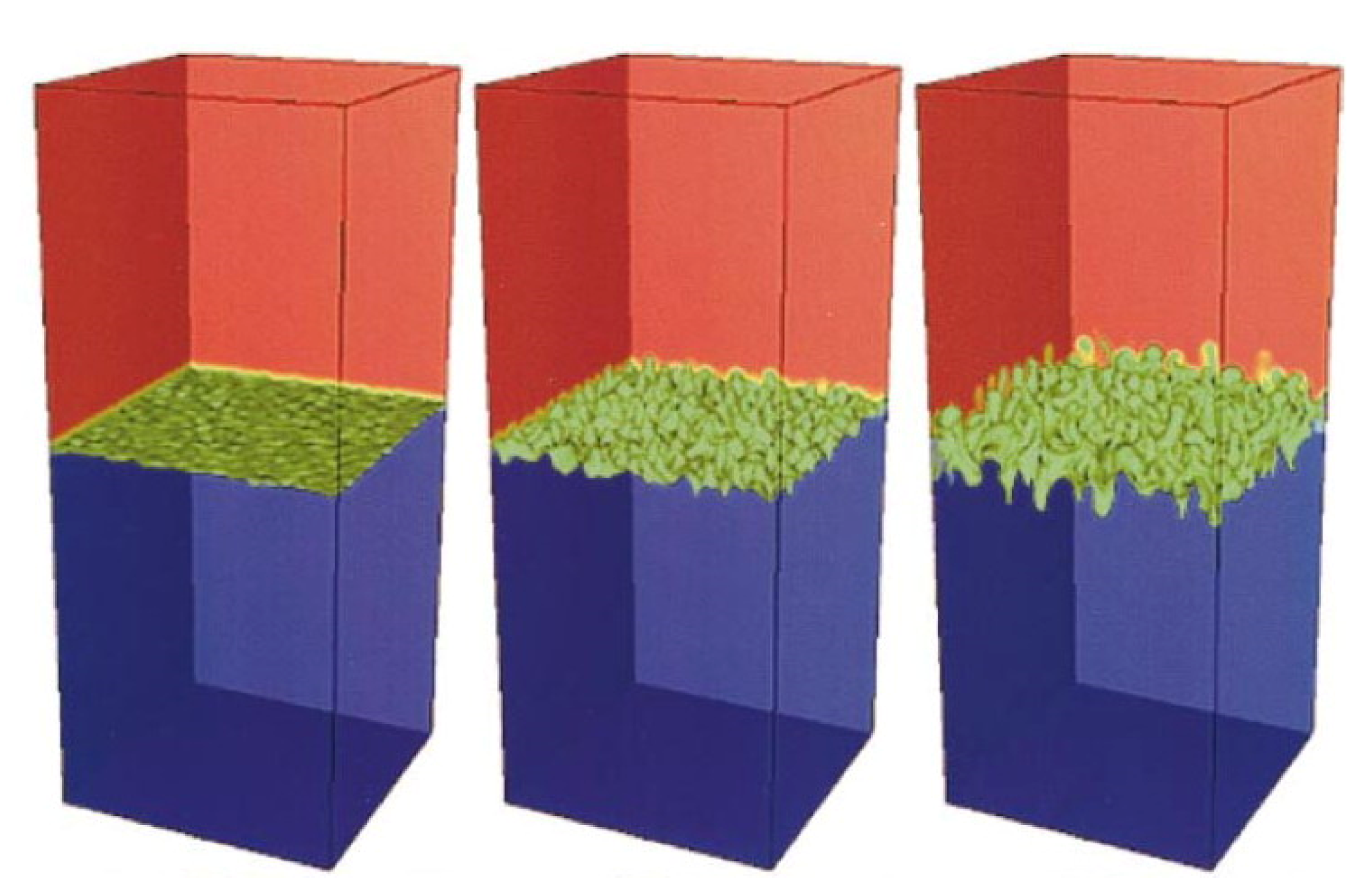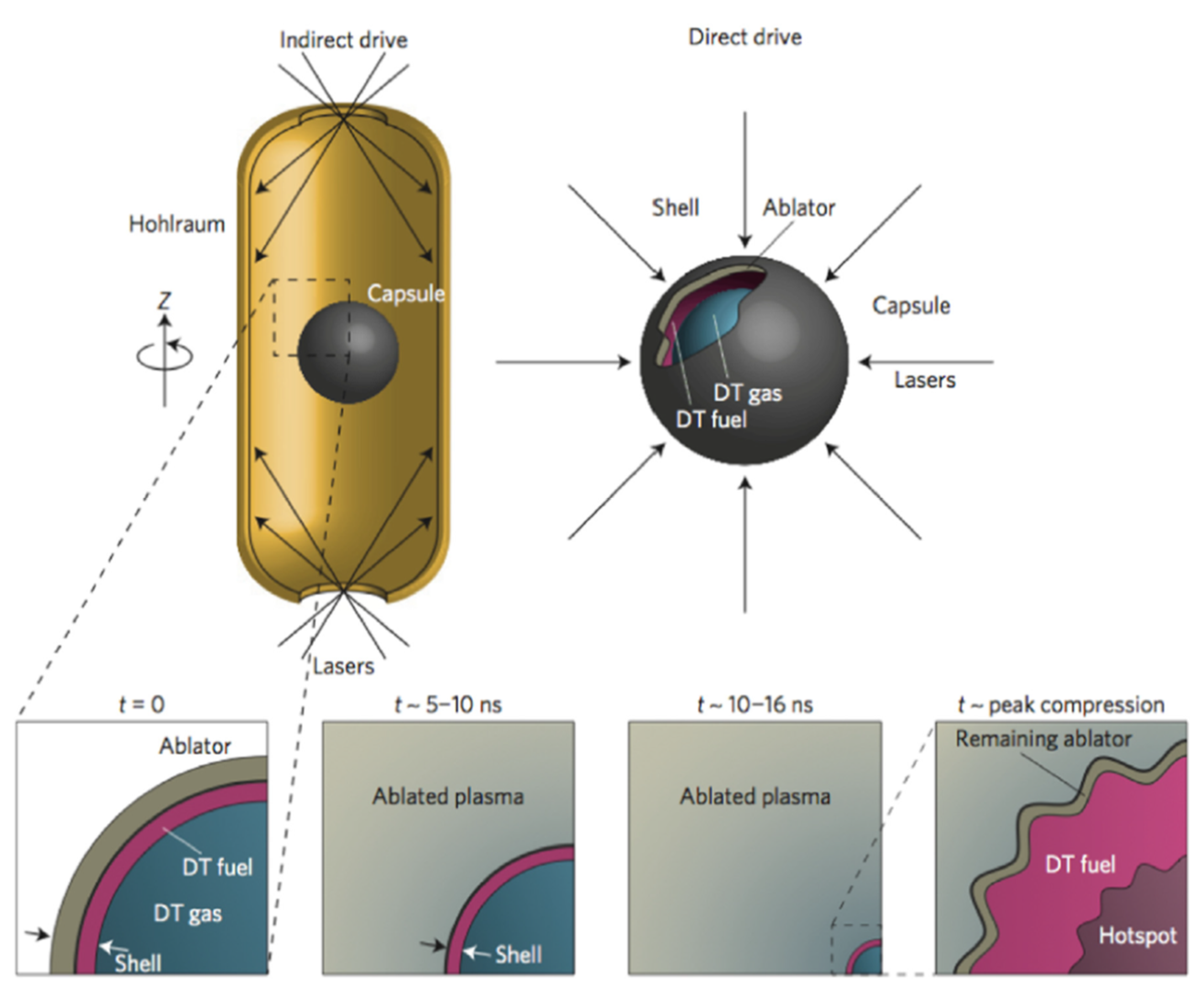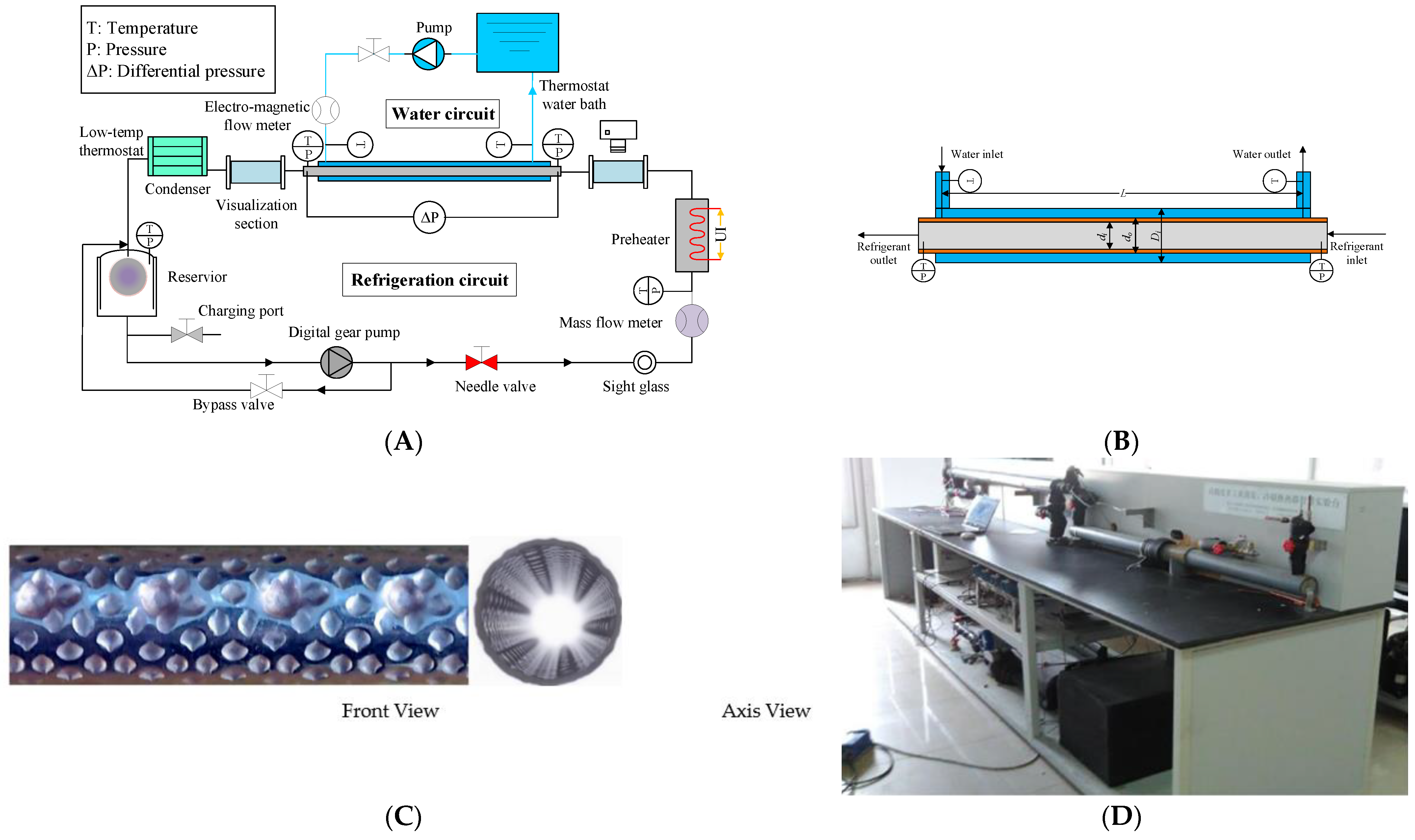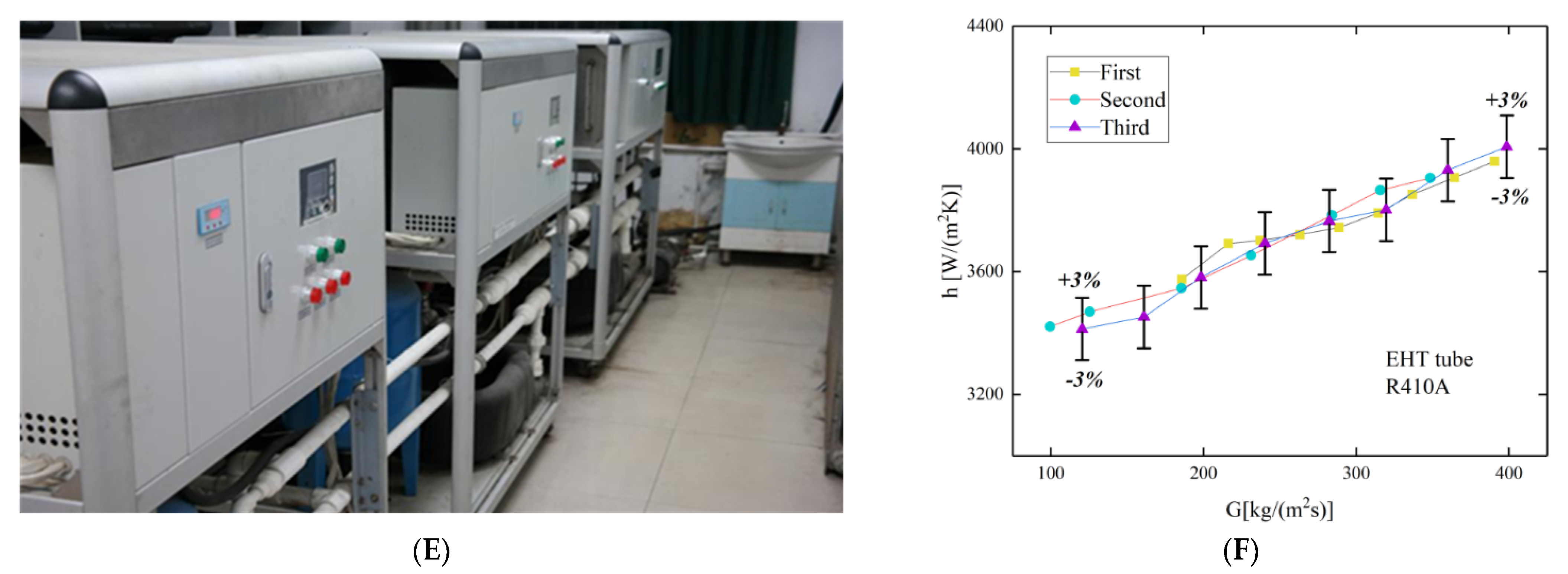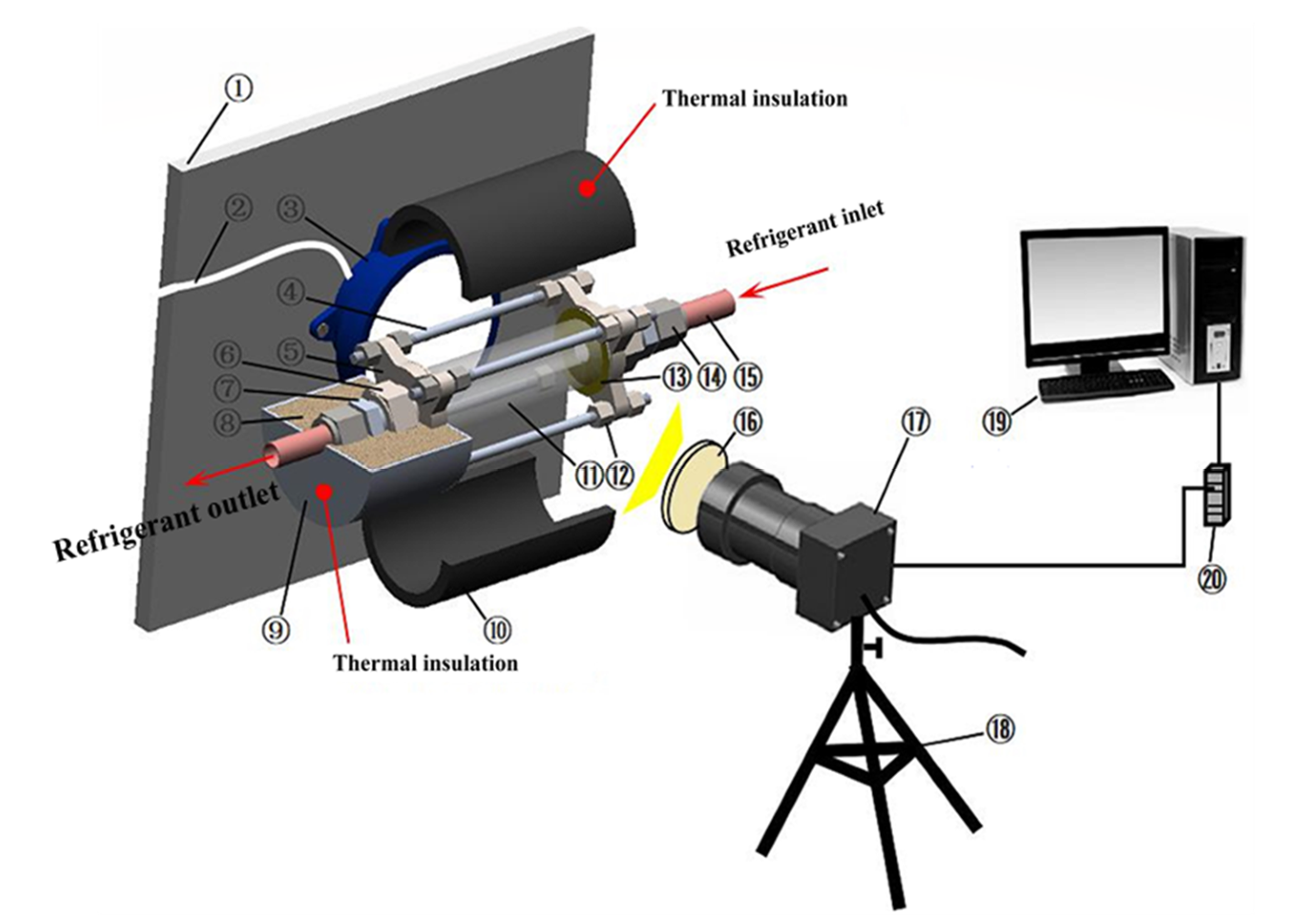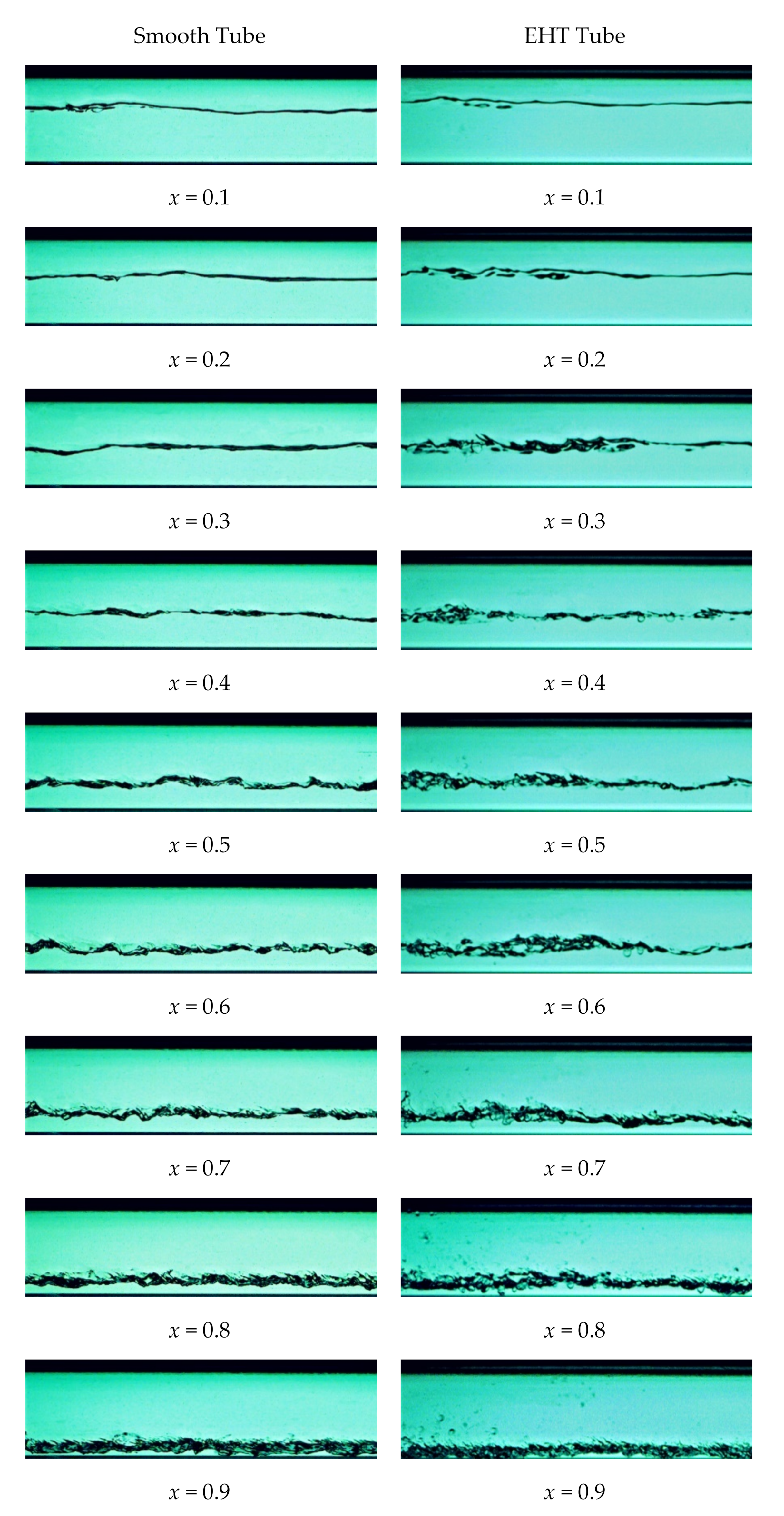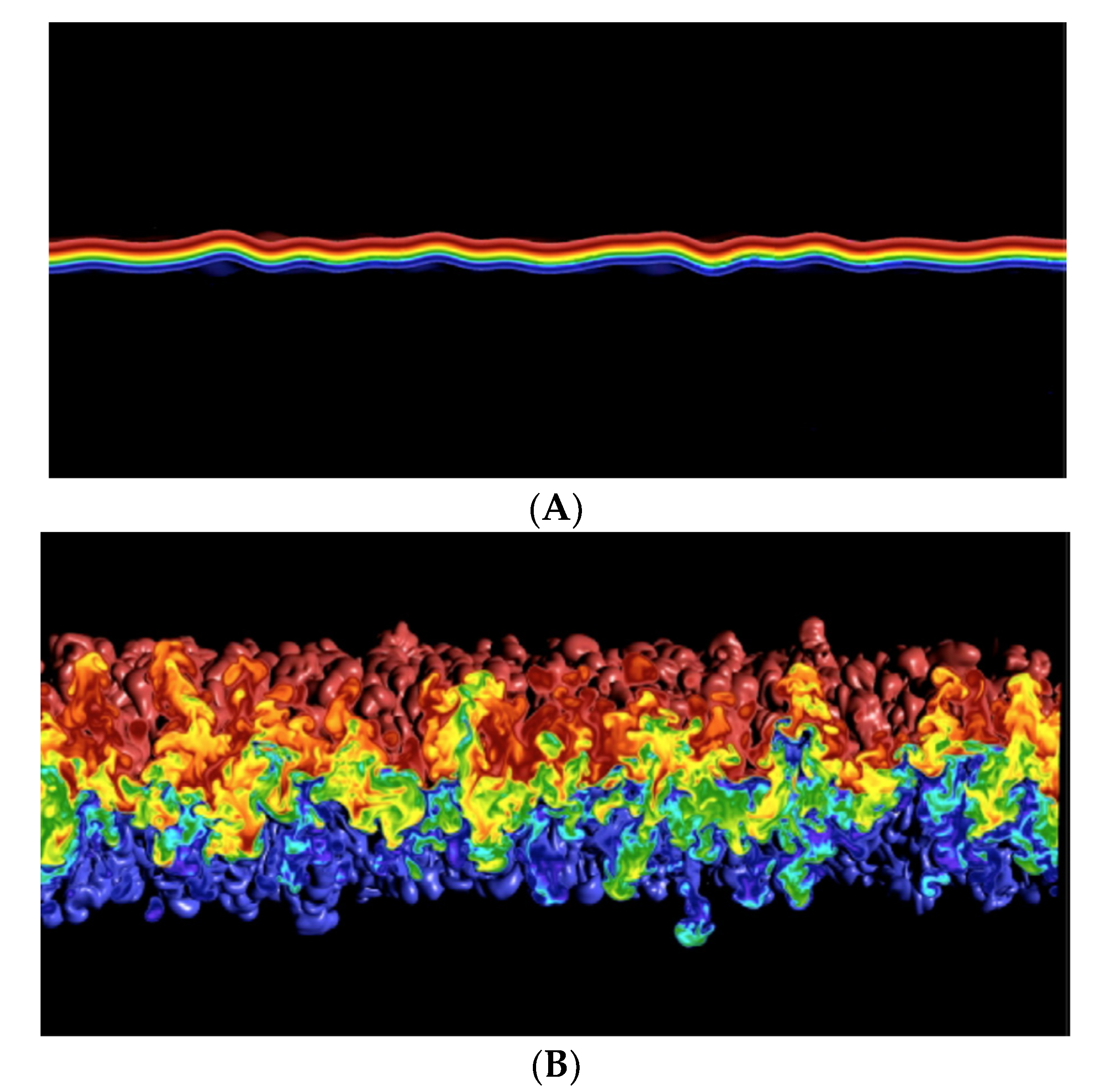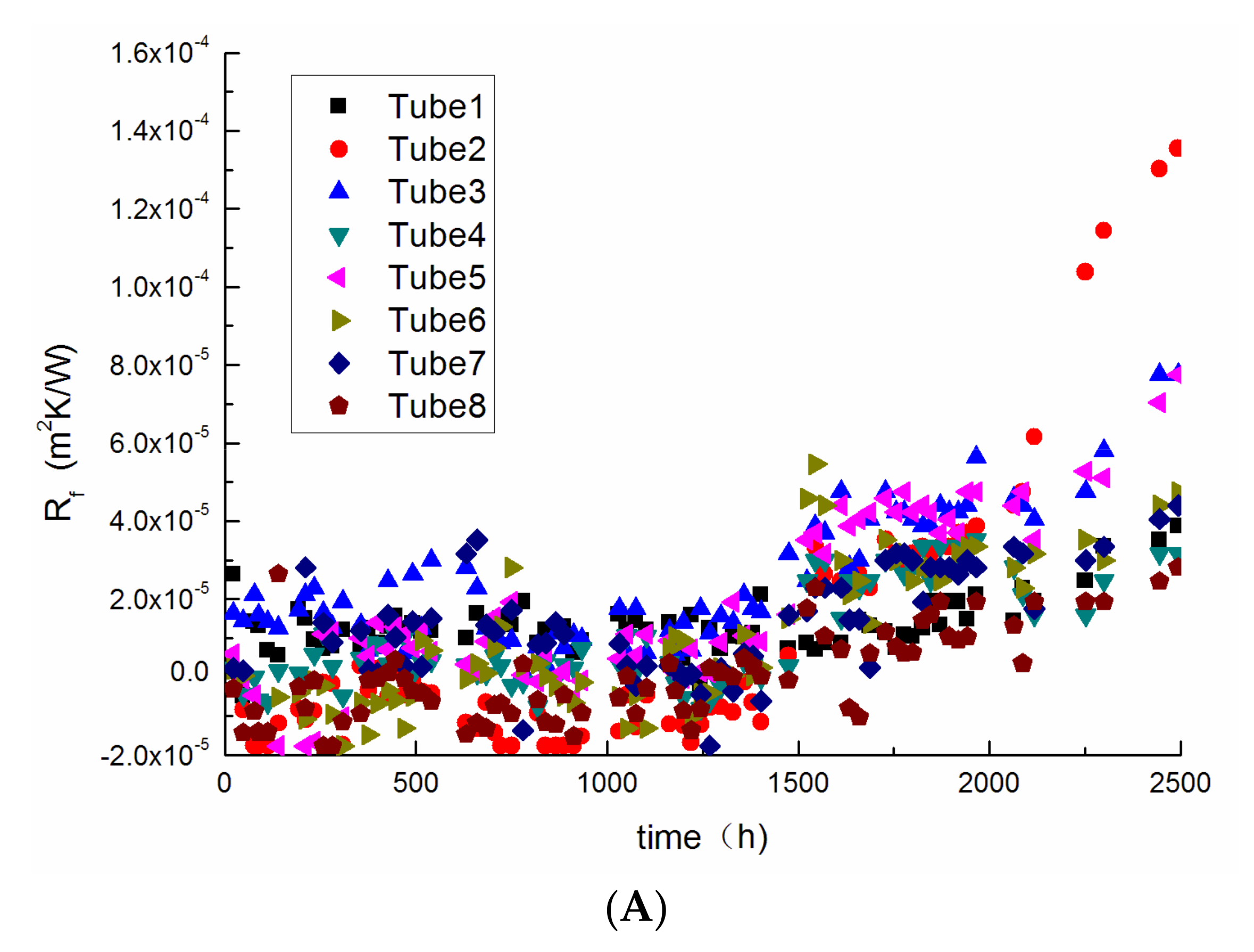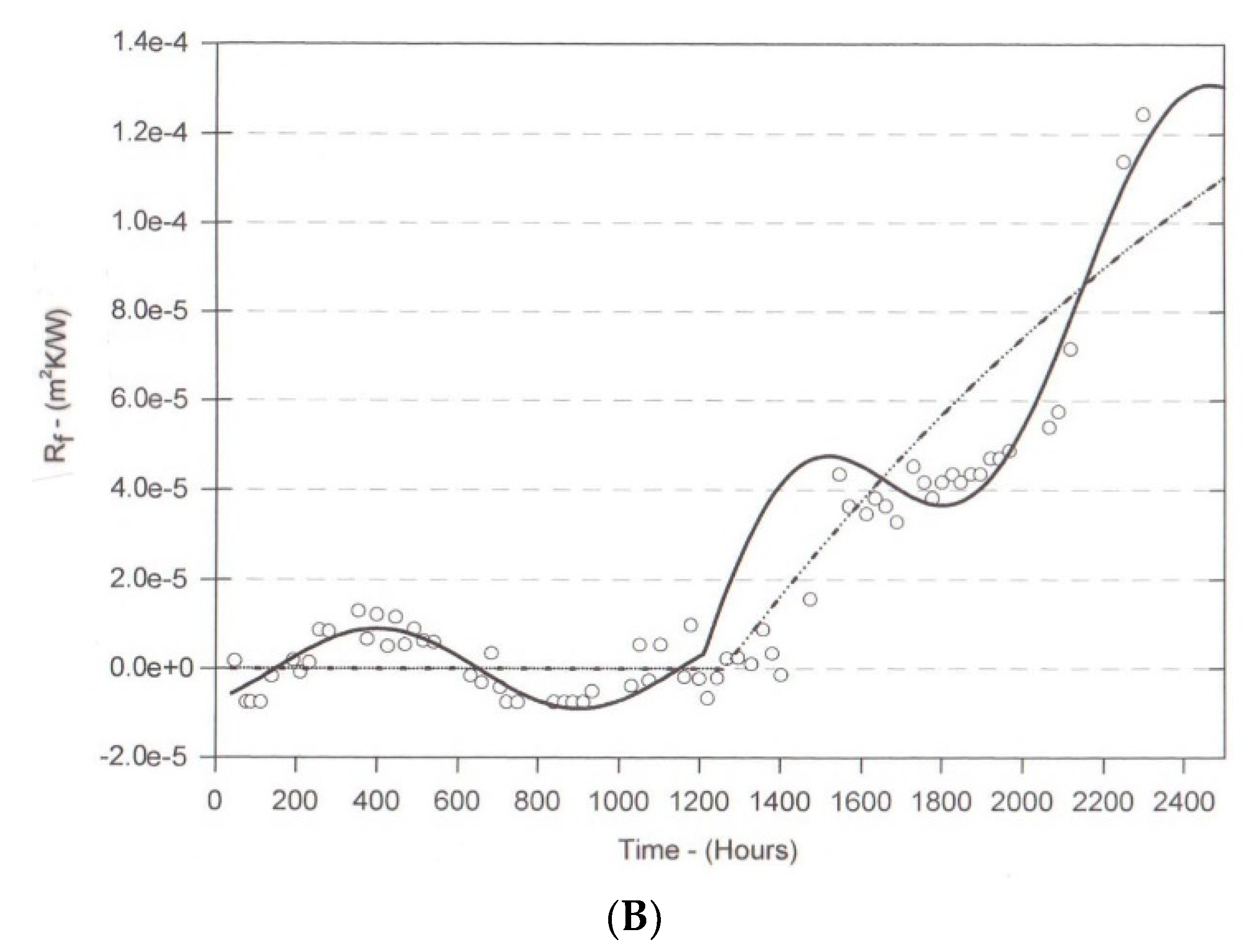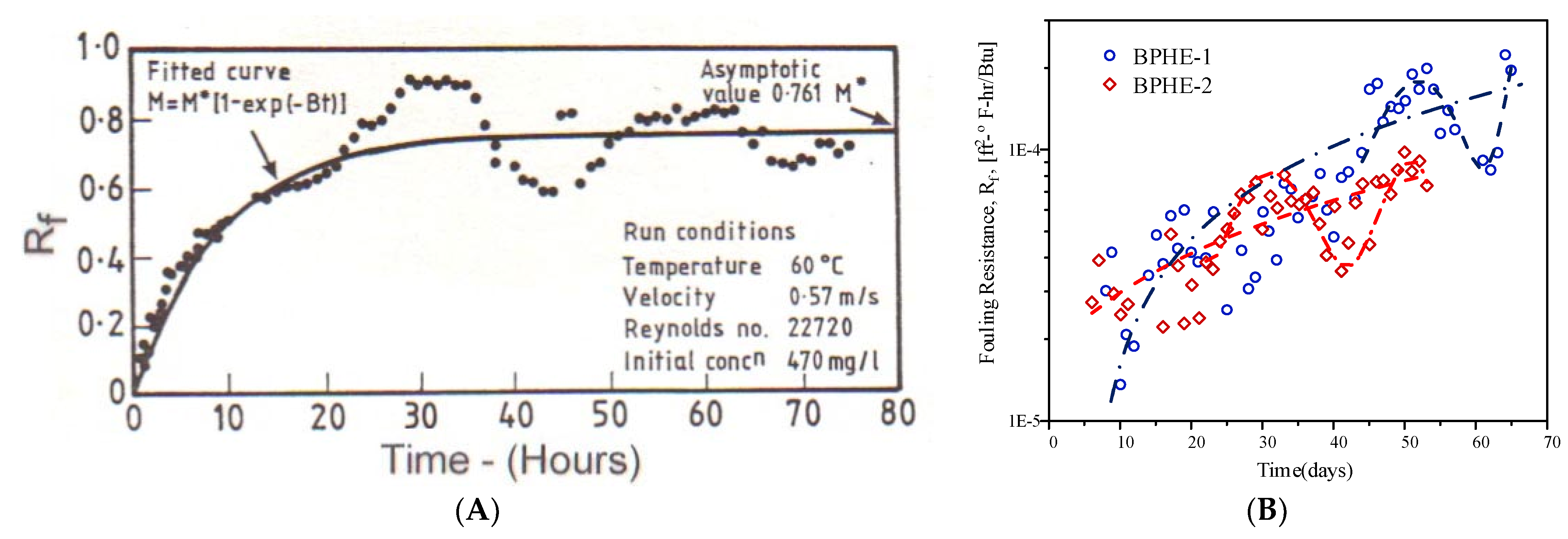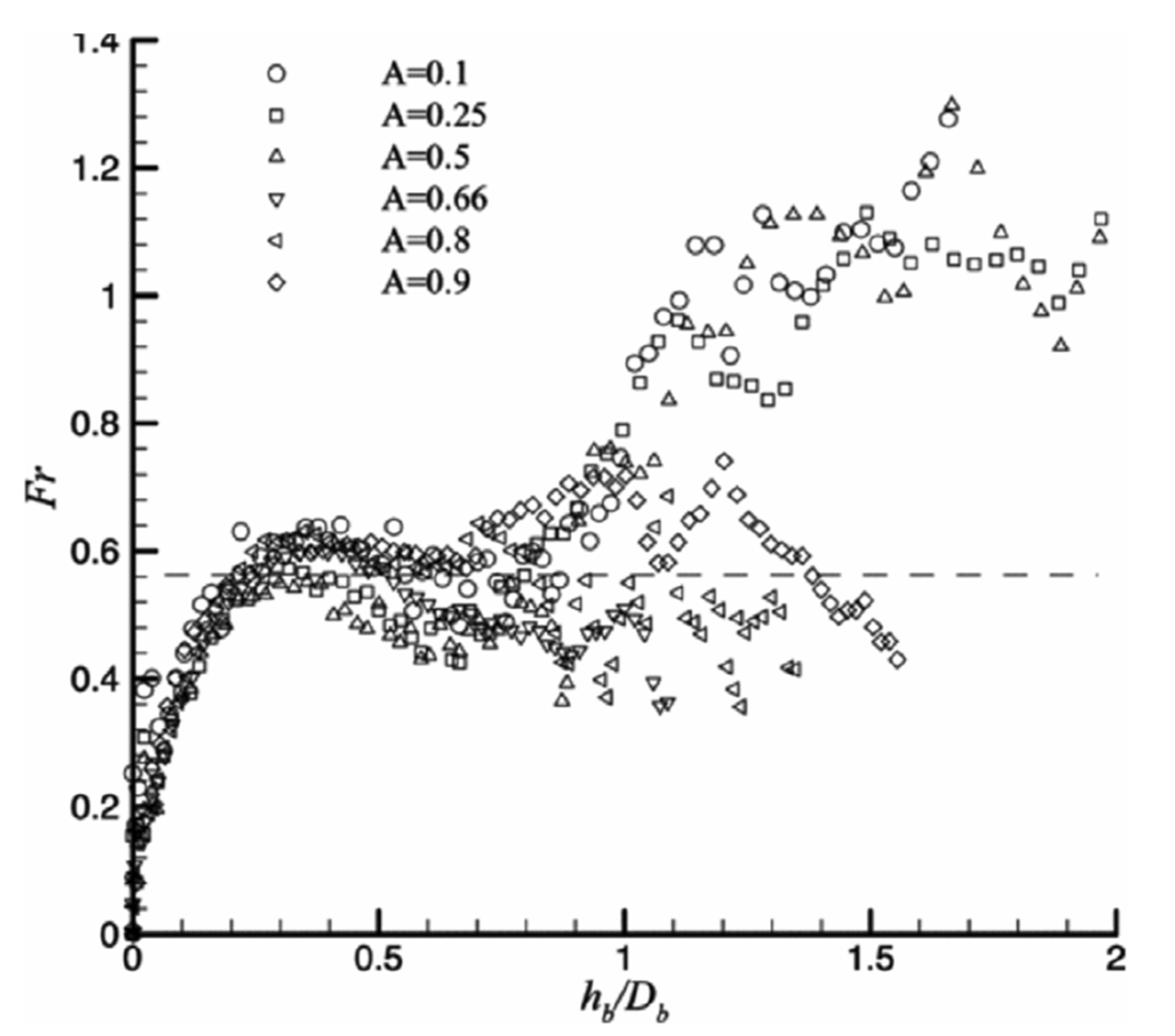3.1. Development of Potential Fluctuation in Spatial Dimensions
Figure 6A shows a schematic of the experimental facility used in the study. A high-precision bench suitable for condensation heat transfer experiments in tubes with various working fluids such as R410A, R32, and R134a was used. A two-phase heat exchange test section consisted of a refrigerant circulation loop and a water circulation loop. Driven by a digital variable frequency pump, the refrigerant entered a preheating section equipped with a smart temperature control system, where the refrigerant was heated. In the test section, a countercurrent sleeve heat exchanger was used for condensation experiments, as shown in
Figure 6B. The effective heat transfer length of the test section was 2.0 m, and a copper tube with an outer diameter of 17.0 mm was selected as the external tube. An enhanced tube with internal petal-like protrusions and staggered dimples (EHT tube) is a complex interior surface tube on the market [
12] as shown in
Figure 6C. Visualizations of flow patterns of condensation flow using refrigerant R410A in smooth and EHT tubes with a diameter of 12.7 mm were conducted. Geometric parameters for the two tested tubes are listed in
Table 1 During the flow condensation experiments, the refrigerant flowed across the tested tubes while the cooling water flowed through the annulus and cooled the refrigerants. The refrigerant flowed from right to left inside a tested tube, and deionized water flowed from left to right in the outer annular region of the tested tube. The exterior of the test section was wrapped with a layer of polyurethane sealant foam, a polyethylene plastic pipe, and a layer of rubber thermal insulation cotton for thermal insulation purposes.
Figure 6D,E shows the physical diagram of the test bench. The test facility, experimental data reduction, and repeat condensation flow heat transfer experiments for validation are described in detail in Sun et al. [
13]. The experiment was conducted at a saturation temperature of 318 K, an outlet vapor quality from 0.1 to 0.9, and at refrigerant R410A mass fluxes of 100 kg/(m
2s). To validate the accuracy of the experimental results, the condensation flow tests of the EHT tube were conducted three times. The experimental results of the heat transfer coefficient for the three times were reproducible within a random error band of ±3% as shown in
Figure 6F, which shows that the experimental data have good reproducibility. The uncertainty of the in-tube heat transfer coefficient is 10.2%, which shows a high test accuracy [
13].
The visualization section was installed at the export of the test section to observe the condensation flow patterns in a smooth tube and an EHT tube, respectively. By minimizing the diameter difference between the tested tube and the quartz glass tube used for observation in the visualization section, possible turbulence caused by sudden expansion or contraction was avoided.
Figure 7 shows a schematic diagram of the image acquisition device. At the central axis between the two stainless steel flanges, a 10 mm quartz glass tube served as a sight glass for flow visualization. Extending from the flange to both sides were stainless steel hex female fittings, reducing hex fittings and hollow nuts welded to the flange. In addition, two copper tubes with a 12.7 mm outside diameter were seamlessly welded to the scope body and the test tube. A Phantom VEO-1010 high-speed camera was utilized to capture the condensation flow patterns with an image acquisition frequency of 4000 fps and a resolution of 1280 × 960 pixels.
Condensation flow patterns inside smooth and EHT horizontal tubes are shown for comparison in
Figure 8. At
x = 0.1, both examples of the approximate appearance of initial interface perturbation in the shape of the sinusoidal function inside the two tubes caused by potential fluctuation defined in Equation (5) are images of refrigerant R410A vapor blowing over an R410A liquid surface. In this situation, the vapor caused a relative motion between the stratified interface of liquid and vapor. Vapor velocity increased as vapor quality
x progressed from 0.1 to 0.9 in the tested tube, enlarging the influence of vapor shear on the condensate. Large magnitude waves were produced, as observed in stratified wavy flows with increasing vapor quality. The initial interface perturbations (for an example, at
x = 0.1) manifest themselves through vapor shears into the form of interpenetrating structures (for an example, at
x = 0.9) being generated on the liquid surface; these are the result of flow instabilities between liquid and vapor. The flow rate of the refrigerant flowing through the smooth tube and the EHT tube is the same, at refrigerant R410A mass fluxes of 100 kg/(m
2s). Under the same vapor quality of the condensing flow, the refrigerant liquid flow velocity in the smooth tube and in the EHT tube is the same, and the flow velocity of the refrigerant vapor in the two tubes is the same. Thus, the difference between the relative flow velocity of the refrigerant liquid and the vapor in the smooth tube and the EHT tube is also the same. Comparing the photos of the refrigerant flow patterns in the smooth tube and the EHT tube under the same vapor quality in
Figure 8, one can see that there is not much difference in the flow patterns between the two photos. Further, in the comparison of the flow patterns between the two columns in
Figure 8, one can observe a good agreement between the flow patterns in the smooth tube and the flow patterns in the EHT tube of the same vapor quality in the same row. The results of the experimental observations are consistent with the inferences of Equation (5). It seems that the double layer enhancement surface of the EHT tube has little effect on the flow patterns. Surface topography alters shear stresses at the tube wall instead of the shear stresses on the condensate. In general, surface topography has little effect on initial interface perturbation and interpenetrating structures because initial interface perturbation and interpenetrating structures are primarily controlled by the potential fluctuation. Potential fluctuation is determined by
ρ1,
v1 and
ρ2,
v2 of the two fluids as determined by the relation of continuity.
Cabot and Cook [
14] show snapshots of density field evolution from DNS of RTI in the fully turbulent regime. The heavy fluid is red, the light fluid is blue, and the mixed fluid is green. The flows are initialized with a stationary interface between the high and low-density fluids, whose vertical position is perturbed with potential fluctuations having a characteristic horizontal wavelength that act to seed the instability. The initial interface perturbations are shown in
Figure 9A. The simulations proceeding to interpenetrating structures, with the mixing layer filling 50% of the domain in the vertical direction, are shown in
Figure 9B.
Figure 8 and
Figure 9 present the visualization of the development of initial interface perturbations to interpenetrating structures of flow instability in spatial dimensions by experimental study and DNS, respectively.
3.2. Development of Potential Fluctuation in the Temporal Dimension
Fouling deposits in cooling tower water can provide the appearance of initial interfacial perturbation. The density
ρ2 of the fouling layer (fouling sediment particles and water) is greater than the density
ρ1 of the fluid (water only) above the fouling layer. The fouling layer and water provide the density and velocity differences needed to observe flow instabilities on the fouling layer surface. As shown in
Figure 10A, a test shell-and-tube condenser was installed parallel with the condenser of a 900-kW chiller in a newly built structure on campus. The cooling tower water supplied to the main refrigerant condenser was supplied to the tested tubes in the condenser. The condenser contained sixteen tubes 3.7 m in length installed as eight identical pairs (seven pairs of helical ridge tubes and one pair with smooth tube geometry). The rationale for pairing is to have one of the tubes in a pair operate as a fouling-free control and have the other tube experience chronic fouling. Tubes are paired horizontally to minimize local differences on the condensate outflow side of the tubes. All eight tubes have an inner tube diameter of 15.54 mm and are made with 1024 fins/inch (0.90 mm high) on the outer surface, as shown in
Figure 10B. The internal geometric parameters of the helical spine tube ranged from the rib start number, helix angle and height defined in
Table 2. Tube 1 is a smooth tube for comparison with the other seven helical spine tubes.
The thermal resistance of the fouling layer was obtained by taking the difference between the heat transfer coefficients of the fouled tube and clean tube in a pair. The tests were carried out under the following operating conditions: Cooling tower water circulated through the tested condenser in a single pass arrangement at a tube side velocity of 1.07 m/s (Re = 16,000). Typical operating conditions were 28.5 °C inlet water temperature, 32.5 °C outlet water temperature and 36.6 °C refrigerant condensation temperature. During a cooling season, data were collected every two days for more than 2570 h. These tests were performed over two cooling seasons in a row to confirm that the fouling data were repeatable [
15]. After the experiment in one cooling season was done, foulant samples were removed and chemically analyzed. Analysis showed that 61% of the fouling deposits were calcium carbonate caused by precipitation fouling. The remaining 39% of the fouling deposits were amorphous particles, including silica (from rust, dirt particles, and sand from cooling air), copper oxide (from copper pipe), iron phosphate/silicate (from iron pipe), and silicic acid aluminum (from unidentified aluminum in the system). Analysis showed that a combination of precipitation and particulate fouling occurred in the experiments. An uncertainty analysis was performed [
16]. Under typical chiller load condition at 4 °C water temperature rise, the experimental uncertainty in
Rf is ±5.7
× 10
6 m
2 K/W. This uncertainty is 12% of the manufacturer’s condenser design rated fouling resistance
Rf of ±4.4
× 10
5 m
2 K/W.
The transport of fouling particles in turbulent flow to the internal tube surface is responsible for the mass transfer of particles to the accumulation surface of a fouling deposit and is part of the combined mechanism of precipitation and particulate fouling. There are three transmission zones: the diffusion zone, the inertia zone, and the impact zone [
17]. As the particles approach the surface, boundary layer effects must be considered. For particles smaller than about 10 μm, direct molecular diffusion across the boundary layer fully explains the experimental results; the particle size in this study is about 3.0 μm. Particle transport is in a diffuse zone. The particles move with the fluid and are brought to the wall by Brownian motion across the viscous sublayer. The micron particles may be regarded as macromolecules. The fouling layer is formed due to the deposition of suspended particles in flow. The density of the fouling layer (water and fouling deposit) is not the same as the density of the fluid (water). The water is above the fouling layer. The fouling layer and water provide the required density difference to observe the participating sinusoidal behavior on the fouling layer surface (the interface between the two densities) controlled by the potential fluctuations defined in Equation (5).
Figure 11A shows cooling tower water fouling data for eight tested tubes. It shows the relationship between thermal resistance (
Rf) and time (
t) of the fouling layer. The eight curves all presented sinusoidal behavior [
18]. The thermal resistance of the fouling layer was directly proportional to the thickness of the fouling layer. Therefore, the thickness of the fouling layers in the eight tested tubes presented sinusoidal curves as a function of time. The data in
Figure 11A are almost overlapped with each other because the cooling tower water fouling data for the eight tested tubes are shown in one figure; the change law seems to be chaotic. To make it clear, the fouling data of Tube 2 is presented individually in
Figure 11B. The figure clearly shows the sinusoidal curve.
Figure 11 presents evidence of the development of potential fluctuation in the temporal dimension.
The curve of Tube 2 can be correlated by a sinusoidal function,
Rf = Asin
(λt) = 2.6
× 10
5 sin(0.0072
t). The temporal fluctuation amplitude (
A) and temporal fluctuation cycle (
λ) for all eight tested tubes are summarized in
Table 2. As can be seen in the table, the temporal fluctuation cycle (λ) for the eight tested tubes is the same (λ = 0.072). This indicates that λ is not a function of the geometric parameters of the surface. This is because λ is a parameter of potential fluctuation defined by Equation (5). It is determined by
ρ1,
v1, and
ρ2,
v2, of the two fluids between the interface, which is the fouling deposit layer in this study, rather than the shear stresses of the tube wall. The temporal fluctuation cycle (λ) of the oscillatory interface between
ρ1 and
ρ2 has no relationship with the surfaces underneath
ρ1 and
ρ2 or the tube wall surfaces constraining the fluids of
ρ1 and
ρ2. As one can see in
Table 2, the amplitude of the fluctuation (A) is a monotone decreasing function of axial element pitch/rib height (
p/e), as is the fouling resistance ratio (
Rf/Rfp).
Rf/Rfp is directly proportional to the thickness of the fouling deposit in the tubes. The thicker the fouling deposit, the larger the amplitude of the fluctuation. Kern and Seaton’s fouling analysis has been a landmark in fouling research since in 1959; they assumed deposit accumulation is the result of two simultaneous opposing events, a constant deposition rate and an increasing removal rate. The removal rate is directly proportional to the thickness of the fouling deposit and the shear stress on the fouling deposit. The different thickness of the fouling deposits resulted in different values of
A for the eight tested tubes. These differences are the result of different situations of shear stress in the eight tested tubes: The flow is interrupted by the rib, the boundary layer close to the wall is separated and then reattaches to the wall downstream of the rib when
p/
e > 5, and the reattachment point vanishes when
p/
e < 5, thus forcing the main flow to “glide over” the ribs and produce secondary flows between the ribs [
19]. The amplitude of the fluctuation (
A), a parameter of potential fluctuation, is affected by shear stresses of the tube wall.
Figure 11 presents the evidence of the development of potential fluctuations in the temporal dimension.
Some studies on sinusoidal fouling curves in the literature include: (i) fouling data for an extended surface heat exchanger and a mass accumulation probe used in a diesel exhaust environment [
20]; (ii) corrosion fouling [
21]; (iii) magnetite particulate deposition from water flowing in aluminum tubes using an X-ray technique [
22] as shown in
Figure 12A; and (iv) the cooling tower water fouling performance of two types of brazed-plate heat exchangers (BPHEs) [
23] in
Figure 12B.
As one can see in
Figure 12B, the wave asymptotic fouling curves for the fouling resistance of cooling tower water in two different brazed-plate heat exchangers (BPHE-1 and BPHE-2, each with a different plate surface) have the same values for
λ because
λ is not a function of the geometric parameters. Temporal wave fouling data, examples of which are shown in
Figure 10 and
Figure 11A,B, have been reported in the literature for more than 50 years; however, they have not yet been theoretically analyzed. Instead, researchers have focused on asymptotic fouling and have ignored temporal sinusoidal fouling due to the belief that its wave behavior was generated because of experimental uncertainty [
16].
Figure 13, adopted from Ramaprabhu et al. [
24], shows the three-dimensional dimensionless Froude numbers obtained for single mode perturbation for RTI. It is the result of numerical simulations.
Figure 11 and
Figure 13 present sinusoidal data of flow instabilities from experimental study and numerical simulations, respectively.
Visualization of condensation flows using refrigerant R410A in one smooth tube and one three-dimensional enhanced tube presents the development of potential fluctuation in spatial dimensions to show that the surface topography of the tube wall has little effect on initial interface perturbation and interpenetrating structures. Due to the limitation of diagnosis capability of the visualization of condensation flow, this method cannot provide detailed information on the spatial fluctuation amplitude and spatial fluctuation cycle of potential fluctuation. Cooling tower fouling in seven helically ridged tubes and one smooth tube present the development of potential fluctuation in the temporal dimension to further show that the surface topography of the tube wall has no effect on the temporal fluctuation cycle and has an obvious effect on temporal fluctuation amplitude due to change of shear stress situations caused by the surface topography of the tube wall.
The theoretical analysis is supported by experimental evidence as shown in
Figure 8 and
Figure 11, as well as previous studies as shown in
Figure 9,
Figure 12 and
Figure 13. Based on visualization of condensation flows and cooling tower water fouling data, deductions can be reached. Potential fluctuation presents a sinusoidal interface in the spatial and temporal dimensions with
A(x,y,z,t) and
λ(x,y,z,t). The
λ(x,y,z,t) and
A(x,y,z,t) are primarily determined based on the densities (
ρ1 and
ρ2) and velocities (
v1 and
v2) of the two fluids involved in the flow instability. The value for
A(x,y,z,t) is affected and
λ(x,y,z,t) is not affected by the stresses caused by surface topography. Direct experimental evidence and quantitative analysis, with the advancement of diagnostic experimental tools and supercomputing power, are needed to obtain more specific information about potential fluctuation.

